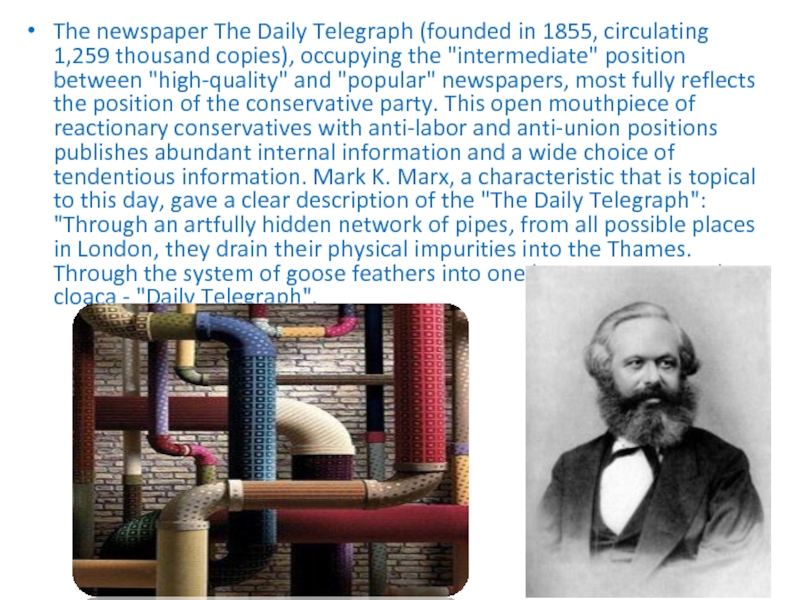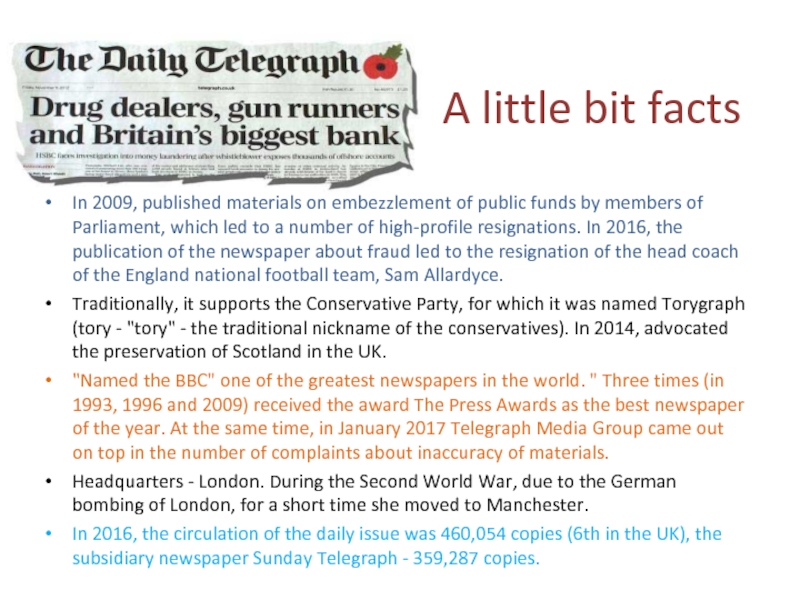- Главная
- Разное
- Дизайн
- Бизнес и предпринимательство
- Аналитика
- Образование
- Развлечения
- Красота и здоровье
- Финансы
- Государство
- Путешествия
- Спорт
- Недвижимость
- Армия
- Графика
- Культурология
- Еда и кулинария
- Лингвистика
- Английский язык
- Астрономия
- Алгебра
- Биология
- География
- Детские презентации
- Информатика
- История
- Литература
- Маркетинг
- Математика
- Медицина
- Менеджмент
- Музыка
- МХК
- Немецкий язык
- ОБЖ
- Обществознание
- Окружающий мир
- Педагогика
- Русский язык
- Технология
- Физика
- Философия
- Химия
- Шаблоны, картинки для презентаций
- Экология
- Экономика
- Юриспруденция
The daily telegraph. History of creation презентация
Содержание
- 1. The daily telegraph. History of creation
- 2. The first cheap newspaper in the Daily
- 3. Founded in 1855 as the Daily
- 4. Special reporting has been commonplace throughout the
- 5. Through the 1970s and ’80s, the Telegraph
- 6. The newspaper The Daily Telegraph (founded in
- 7. The Daily Telegraph is the British full-scale
- 8. A little bit facts In 2009, published
- 9. The Daily Telegraph became the organ of
- 10. Night owls are wealthier and wiser than
- 11. These abilities have been linked to innovative
- 12. Thanks for your attention! Done Leonid Matveev Group 662
Слайд 1The daily telegraph
Slogan of the newspaper «Was, is, and will be».
There
Слайд 2The first cheap newspaper in the Daily Telegraph and Courier (1855),
The newspaper cost only one penny. Thanks to this pricing policy, "The Daily Telegraph" quickly became the "champion" of Britain in circulation and was the ancestor of the so-called "press-for-penny".
Слайд 3
Founded in 1855 as the Daily Telegraph and Courier, the paper
Слайд 4Special reporting has been commonplace throughout the paper’s history. Its correspondents
Слайд 5Through the 1970s and ’80s, the Telegraph remained relatively free of
Слайд 6The newspaper The Daily Telegraph (founded in 1855, circulating 1,259 thousand
Слайд 7The Daily Telegraph is the British full-scale broadband poster newspaper, founded
Слайд 8A little bit facts
In 2009, published materials on embezzlement of public
Traditionally, it supports the Conservative Party, for which it was named Torygraph (tory - "tory" - the traditional nickname of the conservatives). In 2014, advocated the preservation of Scotland in the UK.
"Named the BBC" one of the greatest newspapers in the world. " Three times (in 1993, 1996 and 2009) received the award The Press Awards as the best newspaper of the year. At the same time, in January 2017 Telegraph Media Group came out on top in the number of complaints about inaccuracy of materials.
Headquarters - London. During the Second World War, due to the German bombing of London, for a short time she moved to Manchester.
In 2016, the circulation of the daily issue was 460,054 copies (6th in the UK), the subsidiary newspaper Sunday Telegraph - 359,287 copies.
Слайд 9The Daily Telegraph became the organ of the middle class and
Слайд 10Night owls are wealthier and wiser than larks, study finds They are
By Ben Bryant
7:00AM GMT 25 Mar 2013
Now, however, research on teenagers has found that those who burn the midnight oil are generally brighter and wealthier than early risers.
A study of around 1000 teenagers by the University of Madrid seen by the Independent found that those who preferred to stay up late exhibited the kind of intelligence associated with better jobs and higher salaries.
Researchers looked at the habits and body clocks of the youths and determined whether they liked to stay up late or rise early.
Their school performance, inductive reasoning (or problem solving abilities), academic grades and major subjects were also examined in the study.
Night owls performed better than early risers at inductive reasoning and demonstrated a greater capacity to think conceptually as well as analytically.

















